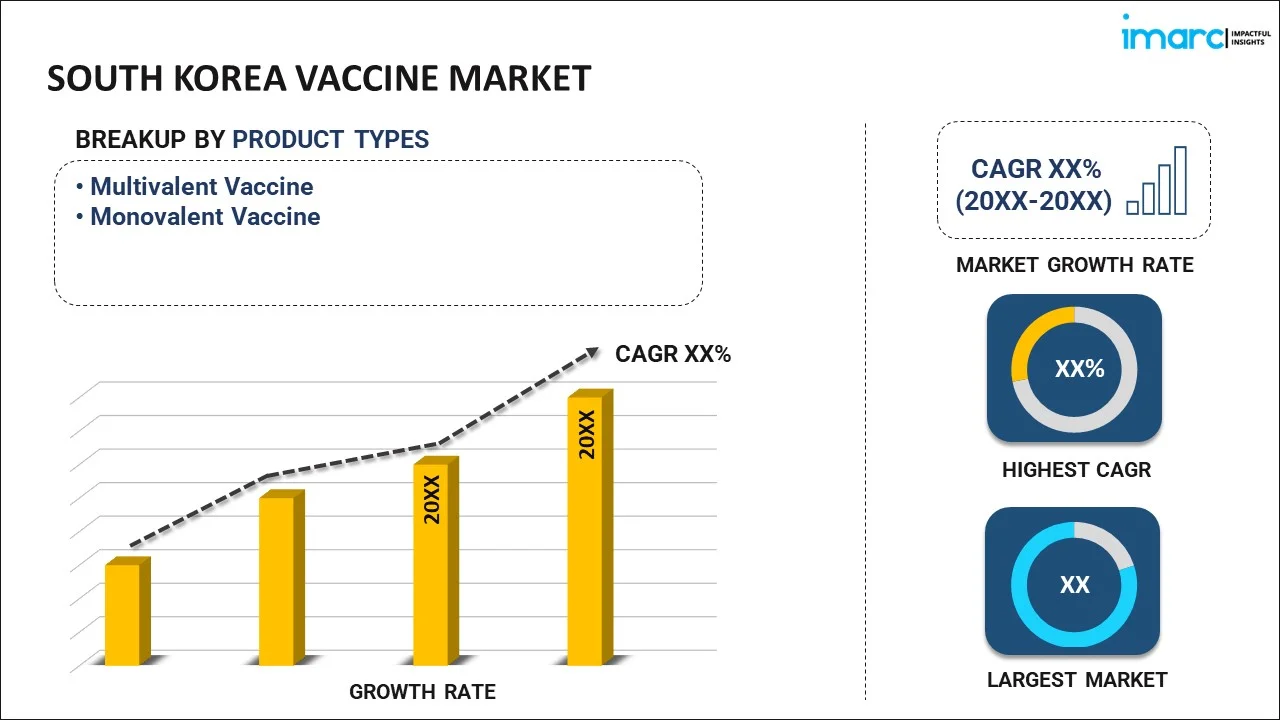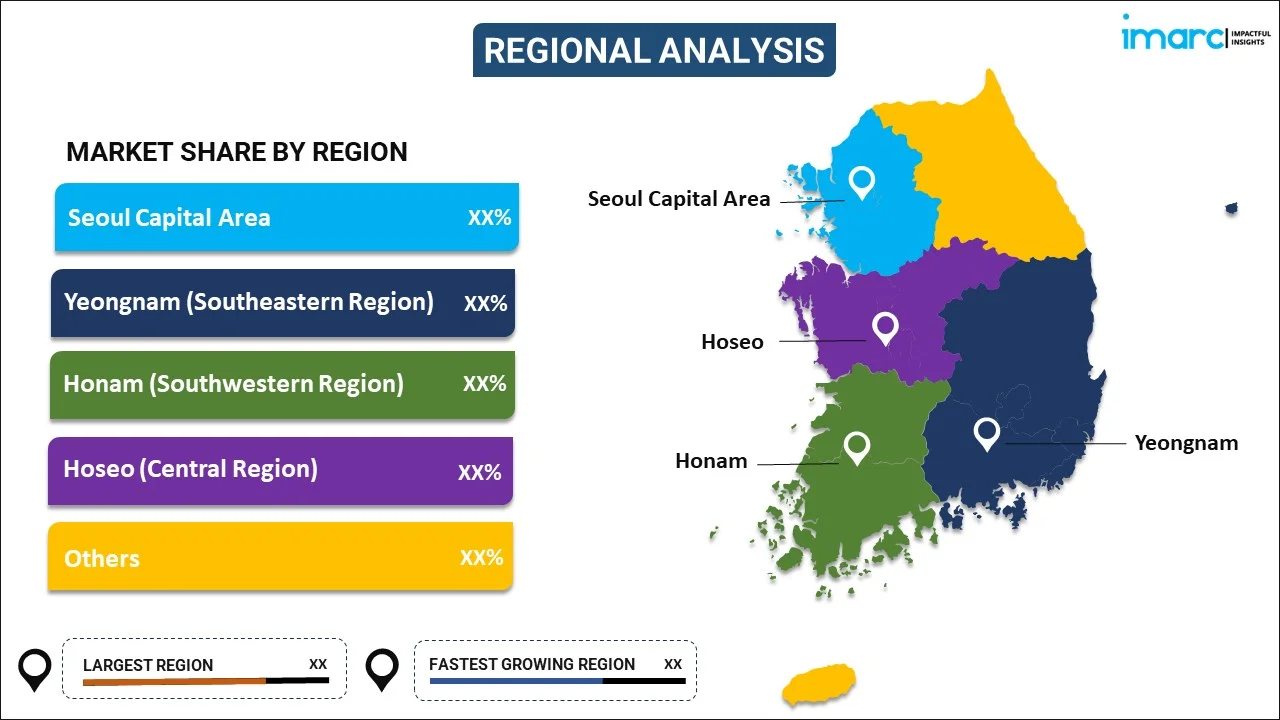
South Korea Vaccine Market Report by Product Type (Multivalent Vaccine, Monovalent Vaccine), Treatment Type (Preventive Vaccine, Therapeutic Vaccine), Technology (Conjugate Vaccines, Inactivated and Subunit Vaccines, Live Attenuated Vaccines, Recombinant Vaccines, Toxoid Vaccines, and Others), Route of Administration (Intramuscular and Subcutaneous Administration, Oral Administration, and Others), Patient Type (Pediatric, Adult), Indication (Bacterial Diseases, Viral Diseases), Distribution Channel (Hospital Pharmacies, Retail Pharmacies, Institutional Sales, and Others), End User (Hospitals, Clinics, Vaccination Centers, Academic and Research Institutes, and Others), and Region 2024-2032
Market Overview:
South Korea vaccine market size is projected to exhibit a growth rate (CAGR) of 4.14% during 2024-2032. The ongoing government commitment to immunization programs, increasing investment in research and development (R&D), rising public health awareness about the importance of vaccines, changing demographic factors, and the growing government support for vaccine exports represent some of the key factors driving the market.
|
Report Attribute
|
Key Statistics
|
|---|---|
|
Base Year
|
2023 |
|
Forecast Years
|
2024-2032
|
|
Historical Years
|
2018-2023
|
| Market Growth Rate (2024-2032) | 4.14% |
Vaccines refer to biological preparations that provide active acquired immunity to a particular infectious disease. They contain various agents resembling a disease-causing microorganism and are often made from weakened or killed forms of the microbe, its toxins, or its surface proteins. Vaccines are available in various types, including live attenuated, inactivated, subunit, toxoid, conjugate, deoxyribonucleic acid (DNA), and recombinant vector vaccines. They are characterized by their safety, specificity, ability to elicit an immune response, and stability. Vaccines are developed using various materials, such as antigens, adjuvants, preservatives, and stabilizers. Their manufacturing process involves antigen discovery, growth of the antigen in culture, purification, and combination with adjuvants and stabilizers. Vaccines are widely used for the prevention of various diseases like measles, polio, influenza, human papillomavirus infection (HPV), and coronavirus (COVID-19). They aid in reducing the incidence of infectious diseases, lowering healthcare costs, and improving life expectancy. In addition to this, vaccines provide several advantages, such as herd immunity, eradication of diseases, minimization of disease-related complications, and promoting long-term health outcomes.
South Korea Vaccine Market Trends:
The increasing government commitment to immunization programs represents one of the key factors propelling the market growth. Additionally, the increasing investment in research and development (R&D) by biopharmaceutical companies, propelling the innovation of new vaccines, is catalyzing the market growth. Besides this, the rising public health awareness about the importance of vaccinations, leading to increased uptake, is supporting the market growth. Furthermore, South Korea’s advanced biotechnology sector, which provides a robust foundation for vaccine development, is fueling the market growth. In addition, the country’s strategic partnerships with global vaccine manufacturers, which enhance the domestic vaccine supply chain, are boosting the market growth. Apart from this, the changing demographic factors, such as the rising geriatric population, which requires vaccines for age-related diseases, are catalyzing the market growth. Moreover, the increasing government support for vaccine exports, which has strengthened South Korea’s position in the global landscape, is acting as another growth-inducing factor. Along with this, the implementation of mass immunization campaigns against seasonal flu and other communicable diseases is contributing to the market growth. In line with this, recent advancements in vaccine technology, such as viral vector vaccines, are supporting the market growth. Additionally, the growing travel and tourism sector, which requires travel-related vaccinations, is stimulating the market growth. Furthermore, the organization of international events in South Korea, promoting the need for vaccines as a public health measure, is positively influencing the market growth. Besides this, the increasing collaborations between academic institutions and industry to promote the rapid development of vaccine candidates are strengthening the market growth across the country.
South Korea Vaccine Market Segmentation:
IMARC Group provides an analysis of the key trends in each segment of the market, along with forecasts at the country level for 2024-2032. Our report has categorized the market based on product type, treatment type, technology, route of administration, patient type, indication, distribution channel, and end user.
Product Type Insights:

- Multivalent Vaccine
- Monovalent Vaccine
The report has provided a detailed breakup and analysis of the market based on the product type. This includes multivalent vaccine and monovalent vaccine.
Treatment Type Insights:
- Preventive Vaccine
- Therapeutic Vaccine
A detailed breakup and analysis of the market based on the treatment type have also been provided in the report. This includes preventive vaccine and therapeutic vaccine.
Technology Insights:
- Conjugate Vaccines
- Inactivated and Subunit Vaccines
- Live Attenuated Vaccines
- Recombinant Vaccines
- Toxoid Vaccines
- Others
The report has provided a detailed breakup and analysis of the market based on the technology. This includes conjugate vaccines, inactivated and subunit vaccines, live attenuated vaccines, recombinant vaccines, toxoid vaccines, and others.
Route of Administration Insights:
- Intramuscular and Subcutaneous Administration
- Oral Administration
- Others
A detailed breakup and analysis of the market based on the route of administration have also been provided in the report. This includes intramuscular and subcutaneous administration, oral administration, and others.
Patient Type Insights:
- Pediatric
- Adult
The report has provided a detailed breakup and analysis of the market based on patient type. This includes pediatric and adult.
Indication Insights:
- Bacterial Diseases
- Meningococcal Disease
- Pneumococcal Disease
- Diphtheria/Tetanus/Pertussis (DPT)
- Tuberculosis
- Haemophilus Influenzae (Hib)
- Typhoid
- Others
- Viral Diseases
- Hepatitis
- Influenza
- Human Papillomavirus (HPV)
- Measles/Mumps/Rubella (MMR)
- Rotavirus
- Herpes Zoster
- Varicella
- Japanese Encephalitis
- Rubella
- Polio
- Rabies
- Dengue
- Others
A detailed breakup and analysis of the market based on the indication have also been provided in the report. This includes bacterial diseases (meningococcal disease, pneumococcal disease, diphtheria/tetanus/pertussis (DPT), tuberculosis, haemophilus influenzae (Hib), typhoid, others) and viral diseases (hepatitis, influenza, human papillomavirus (HPV), measles/mumps/rubella (MMR), rotavirus, herpes zoster, varicella, Japanese Encephalitis, rubella, polio, rabies, dengue, and others).
Distribution Channel Insights:
- Hospital Pharmacies
- Retail Pharmacies
- Institutional Sales
- Others
The report has provided a detailed breakup and analysis of the market based on distribution channel. This includes hospital pharmacies, retail pharmacies, institutional sales, and others.
End User Insights:
- Hospitals
- Clinics
- Vaccination Centers
- Academic and Research Institutes
- Others
A detailed breakup and analysis of the market based on the end user have also been provided in the report. This includes hospitals, clinics, vaccination centers, academic and research institutes, and others.
Regional Insights:

- Seoul Capital Area
- Yeongnam (Southeastern Region)
- Honam (Southwestern Region)
- Hoseo (Central Region)
- Others
The report has also provided a comprehensive analysis of all the major regional markets, which include Seoul Capital Area, Yeongnam (Southeastern Region), Honam (Southwestern Region), Hoseo (Central Region), and others.
Competitive Landscape:
The market research report has also provided a comprehensive analysis of the competitive landscape. Competitive analysis such as market structure, key player positioning, top winning strategies, competitive dashboard, and company evaluation quadrant has been covered in the report. Also, detailed profiles of all major companies have been provided.
South Korea Vaccine Market Report Coverage:
| Report Features | Details |
|---|---|
| Base Year of the Analysis | 2023 |
| Historical Period | 2018-2023 |
| Forecast Period | 2024-2032 |
| Units | US$ Million |
| Scope of the Report | Exploration of Historical Trends and Market Outlook, Industry Catalysts and Challenges, Segment-Wise Historical and Future Market Assessment:
|
| Product Types Covered | Multivalent Vaccine, Monovalent Vaccine |
| Treatment Types Covered | Preventive Vaccine, Therapeutic Vaccine |
| Technologies Covered | Conjugate Vaccines, Inactivated and Subunit Vaccines, Live Attenuated Vaccines, Recombinant Vaccines, Toxoid Vaccines, Others |
| Route of Administrations | Intramuscular and Subcutaneous Administration, Oral Administration, Others |
| Patient Types Covered | Pediatric, Adult |
| Indications Covered |
|
| Distribution Channels Covered | Hospital Pharmacies, Retail Pharmacies, Institutional Sales, Others |
| End Users Covered | Hospitals, Clinics, Vaccination Centers, Academic and Research Institutes, Others |
| Regions Covered | Seoul Capital Area, Yeongnam (Southeastern Region), Honam (Southwestern Region), Hoseo (Central Region), Others |
| Customization Scope | 10% Free Customization |
| Report Price and Purchase Option | Single User License: US$ 3699 Five User License: US$ 4699 Corporate License: US$ 5699 |
| Post-Sale Analyst Support | 10-12 Weeks |
| Delivery Format | PDF and Excel through Email (We can also provide the editable version of the report in PPT/Word format on special request) |
Key Questions Answered in This Report:
- How has the South Korea vaccine market performed so far and how will it perform in the coming years?
- What has been the impact of COVID-19 on the South Korea vaccine market?
- What is the breakup of the South Korea vaccine market on the basis of product type?
- What is the breakup of the South Korea vaccine market on the basis of treatment type?
- What is the breakup of the South Korea vaccine market on the basis of technology?
- What is the breakup of the South Korea vaccine market on the basis of route of administration?
- What is the breakup of the South Korea vaccine market on the basis of patient type?
- What is the breakup of the South Korea vaccine market on the basis of indication?
- What is the breakup of the South Korea vaccine market on the basis of distribution channel?
- What is the breakup of the South Korea vaccine market on the basis of end user?
- What are the various stages in the value chain of the South Korea vaccine market?
- What are the key driving factors and challenges in the South Korea vaccine?
- What is the structure of the South Korea vaccine market and who are the key players?
- What is the degree of competition in the South Korea vaccine market?
Key Benefits for Stakeholders:
- IMARC’s industry report offers a comprehensive quantitative analysis of various market segments, historical and current market trends, market forecasts, and dynamics of the South Korea vaccine market from 2018-2032.
- The research report provides the latest information on the market drivers, challenges, and opportunities in the South Korea vaccine market.
- Porter's five forces analysis assist stakeholders in assessing the impact of new entrants, competitive rivalry, supplier power, buyer power, and the threat of substitution. It helps stakeholders to analyze the level of competition within the South Korea vaccine industry and its attractiveness.
- Competitive landscape allows stakeholders to understand their competitive environment and provides an insight into the current positions of key players in the market.
Need more help?
- Speak to our experienced analysts for insights on the current market scenarios.
- Include additional segments and countries to customize the report as per your requirement.
- Gain an unparalleled competitive advantage in your domain by understanding how to utilize the report and positively impacting your operations and revenue.
- For further assistance, please connect with our analysts.
 Inquire Before Buying
Inquire Before Buying
 Speak to an Analyst
Speak to an Analyst
 Request Brochure
Request Brochure
 Request Customization
Request Customization




.webp)




.webp)












